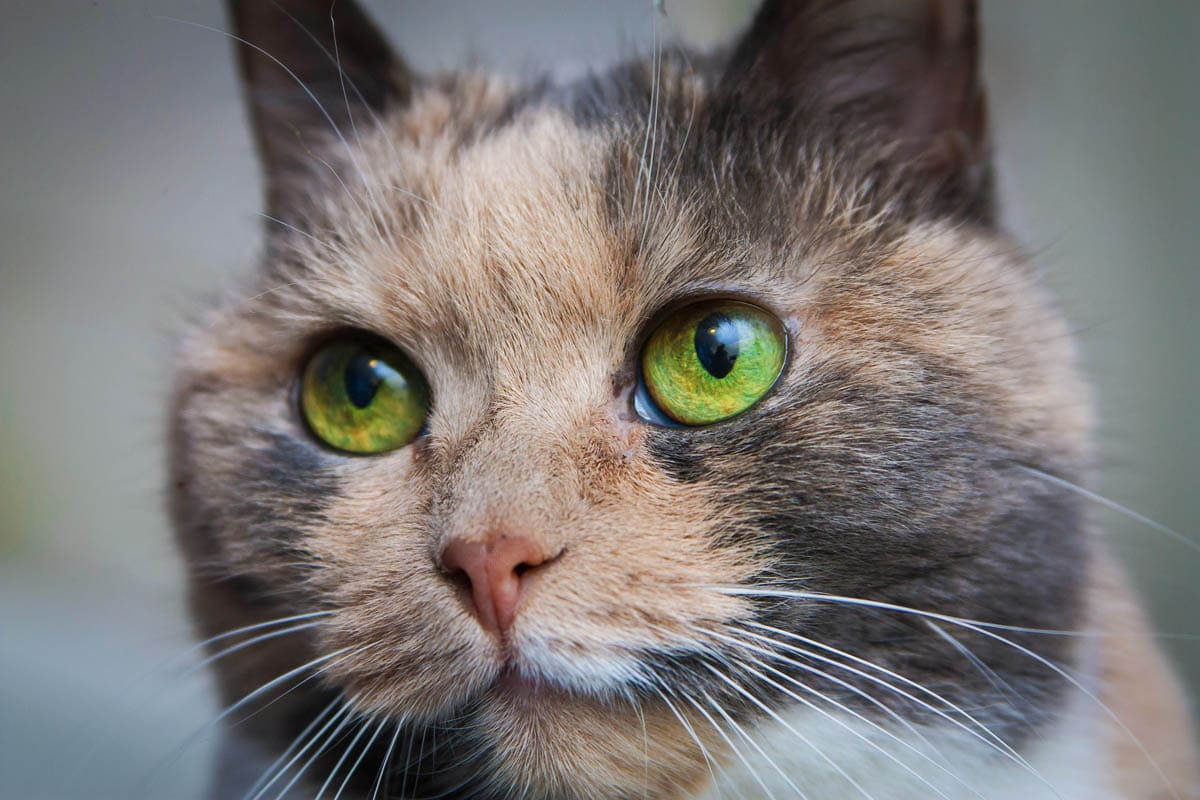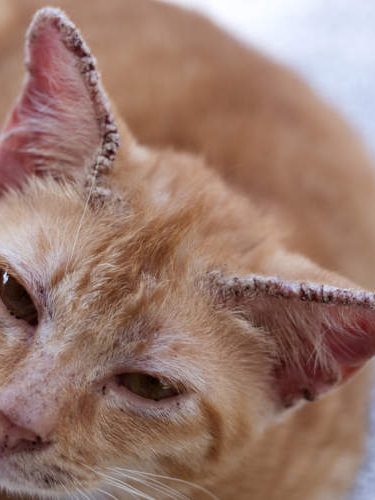When I was in practice, I frequently saw cats with skin disorders. As the largest organ in a cat’s body, the skin is the first line of defense. It’s no surprise, then, that cat’s skin is prone to developing a wide range of conditions. On top of the list of dermatologic diseases for cats, you will find skin infections. In this article, we’ll discuss the major skin infections in cats so that you can recognize them and give your kitty the help she needs to deal with the condition.
About skin infections in cats
Most skin infections in cats are “secondary” – which means they are caused by an underlying disorder. The primary reasons cats develop skin infections are:
- trauma (such as a bite or scratch),
- self-mutilation (over-grooming, biting, or scratching itchy skin ),
- endocrine disorders and poor immunity.
Although parasites such as mange can trigger skin infections in cats, yeast, fungi, and bacteria are usually the causative factors. Infections can affect the superficial or deeper layers of the skin.
The two most common types of bacteria that cause skin infections in cats are Staphylococcus pseudointermedius and Pasteurella multocida. Ringworm is the most common fungal skin infection in cats, but there are other causative factors.
Several factors may influence the likelihood of a cat developing a skin infection.
- gender
- age
- lifestyle
- breed
- environment
- presence of another disease
First category: Fungal skin infections in cats
Fungal skin infections are common in cats and are caused by spore-producing organisms in the environment. Usually, healthy felines can fight off the fungal invasion. But cats that are stressed, ill, or immune-compromised may be at risk of picking up an infection from the soil or another infected cat. Many fungal infections that affect cats can be transmitted to humans.
The most common fungal infection in cats are:
1. Ringworm:
Ringworm, also known as dermatophytosis, is the most common fungal skin infection in cats. It’s generally characterized by:
- hair loss
- crusty or scaly skin
- a circular rash around the infection
- inflammation and redness
- broken hairs at the infection site
Some cats are silent carriers of the disease and do not show any skin changes. Usually, ringworm infections will resolve on their own, but they are extremely contagious and transmissible to humans. Therefore, treatment is recommended.
The usual treatment for ringworm is topical antifungal creams/ointments and medicated shampoo. If the infection is severe, your veterinarian may also prescribe oral medications. The average cost of treatment is about $100. Most cats recover in a few weeks. Ringworm can recur, so it’s important to decontaminate the environment any time your cat has an infection. Wash or change your cat’s bedding daily until she recovers. You should also consider discarding any unwashable toys and replacing them. View more pictures of ringworm in cats, with information from our veterinarian team.
Other types of fungal infections
There are some other less common fungal infections that can affect cats. They include:
2. Cryptococcosis:
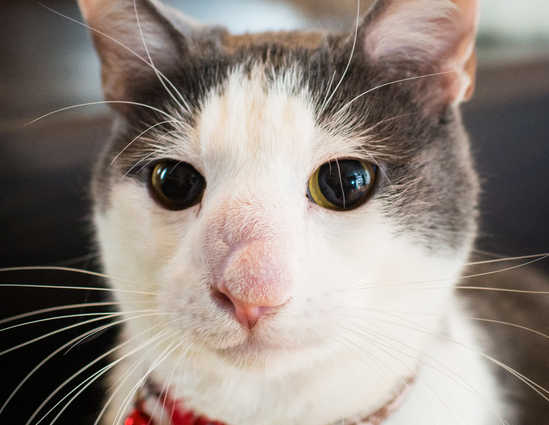
A common infectious disease, cryptococcosis is caused by the yeast-like fungus Cryptococcus neoformans. This fungus is widespread in the environment and infection can occur in cats, dogs, humans, and other animals. Cats often inhale the organism from the soil and the fungus triggers upper respiratory and skin symptoms, including:
- sneezing
- nasal polyps
- nasal discharge that can be clear, yellow, or blood-tinged
- hard swelling of the nose bridge
- firm or fluid-filled nodules or papules
- skin ulcers
Cryptococcus organisms can also enter the bloodstream and cause systemic infections.
The treatment for cryptococcosis is usually oral antifungal treatment. For mild to moderate infections, a four-month course of fluconazole or a nine-month round of itraconazole. The medications can affect the liver, so follow-up monitoring is required. Treatment and monitoring may last a year or longer. The cost of treatment can be $200-800 or more.
While recovery may take 6-18 months, the prognosis is good. About 20% of cats can relapse and require a second round of treatment.
3. Blastomycosis:
Blastomycosis is a zoonotic systemic infection caused by the dimorphic microfungus Blastomyces dermatitidis. The organism is present in moist soil and areas of thick decaying matter such as river banks, lakes, swamps, forests, and woods. It is most prevalent in the mid-Atlantic, north-central, and Ohio-Mississippi river valley areas.
Blastomycosis primarily causes respiratory disease including pneumonia, but it can also affect the nervous system and skin of cats. Signs of blastomycosis in the skin include abscesses and masses. Cats with the infection may also have a fever, lethargy, and weight loss.
Several months of oral itraconazole is the usual treatment for blastomycosis. During this time, your veterinarian will regularly monitor your cat’s organ function to check for liver damage. Cost of treatment is about $500-3,000 depending on the severity of the infection. Cats that survive the first few weeks of treatment generally have a good prognosis. There are usually no negative side effects following infection.
4. Sporotrichosis:

Sporotrichosis is a rare zoonotic (transmissible to humans and other animals) fungal infection of humans and animals which is caused by the fungus Sporothrix schenckii. The organism is present in the soil, wood, and living and decaying plant material. In humans, the infection is known as rose gardener’s disease. Outdoor workers such as farmers, forestry workers, gardeners, and nursery employees are at the highest risk.
Signs of sporotrichosis skin infections in cats include:
- nodules/lumps under the skin
- draining wounds
- blood or pus discharge
- swelling and redness around the lesion
Sporotrichosis mimics other cutaneous diseases, so your veterinarian will need to run diagnostic tests including bloodwork, a urinalysis, and skin cytology. The treatment for this condition is usually at least two months of oral itraconazole and costs about $500-800. Prognosis for recovery is good.
5. Histoplasmosis:
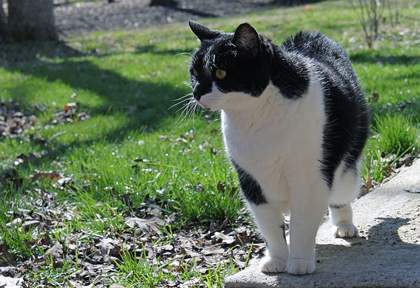
Caused by the fungus Histoplasma capsulatum, histomplasmosis thrives in moist and humid conditions, particularly in areas that have been contaminated with bird or bat droppings. Cats become infected when they inhale or ingest fungal spores from the surroundings. The distribution of the fungus includes Mississippi, Missouri, Ohio River Valleys and the mid-Atlantic states, Latin America, Africa, Australia and parts of East Asia.
Usually, cats with histoplasmosis exhibit weight loss, loss of appetite, and respiratory difficulty. Less common signs include:
- lameness
- eye discharge
- fever
- diarrhea
- enlarged lymph nodes
- draining skin lesions
Cats with histoplasmosis are usually treated with a four to six-month course of oral fluconazole or itraconazole. Depending on the severity of the infection and the systems involved, supportive care may include IV fluids, antibiotics, and oxygen. The cost of treating histoplasmosis is about $500-2000. The prognosis for recovery is fairly good.
Second category: Bacterial skin infections in cats
6. pyoderma on cat skin

Bacterial skin infections, or pyoderma, are usually caused by bacterial organisms that reside on cat skin. It’s usually a secondary infection that can be caused by:
- allergic dermatitis
- skin parasites
- fungal infections
Signs of pyoderma in a cat include:
- scaling skin
- small, hard bumps(miliary dermatitis)
- pussy discharge
- inflammation and redness
- itching and licking the area
- foul odor
- painful skin lesions
Bacterial skin infections can be superficial(affecting the skin’s surface) or deep(penetrating deeper layers of the skin). Superficial infections usually exhibit inflammation and a pussy discharge. The deep infections are more painful. Usually, the bacteria Staphylococcus intermedius is the causative factor, but pyoderma in cats can also result from infections with E. coli, Pseudomonas, or proteus species.
To treat pyoderma, your veterinarian will run cultures to identify the bacteria and prescribe the appropriate oral or topical antibiotics and medicated shampoo. He may also recommend supplements that are rich in Vitamins C and E and zinc to support your cat’s immune system. If the lesions are itchy, you may need to use an E-collar to prevent your cat from licking the area. The prognosis for recovery is good.
Yeast infections in cats
Yeast is a type of mold that reproduces by budding. It commonly occurs in the environment and on your cat’s skin. Normally, yeast is not pathogenic, but when a cat is immunocompromised, the organism may overgrow and colonize the area leading to an infection.
The most common types or forms of yeast infections in cats include:
7. Candidiasis
Candidiasis is relative rare in cats and the skin is not always involved. However, when it occurs, we may see localized fur loss and scaling, as shown on the cats below.
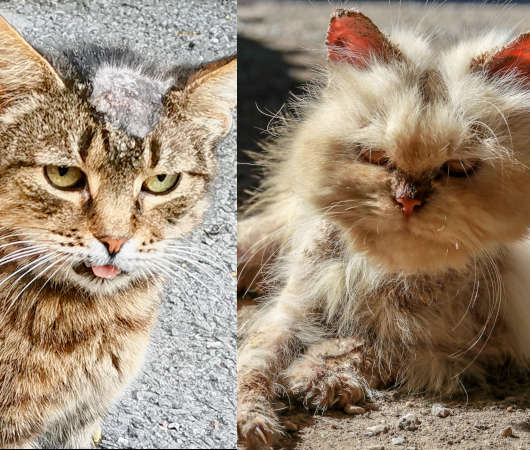
Candida albicans is part of the normal flora and occurs in the mouth, nose, ears, gastrointestinal and genitourinary tracts. Yeast infections are uncommon in cats, but when it happens it can make your kitty extremely uncomfortable. Symptoms of infection vary depending on the location, but may include:
- frequent itching
- hair loss and dandruff
- drooling if thrush is present
- reddened, irritated skin
- heavy wax buildup in ears
- diarrhea
- skin and eye lesions
- lethargy
To treat candidiasis, your veterinarian will prescribe medicated ointments or creams for the skin lesions and medicated shampoo. If the infection is severe, or your cat has long hair, he will also use oral medication. The cost of treatment varies but usually ranges from $200-1400. Cats should recover from skin infection symptoms in about 2 weeks. If the signs persist for more than a month, notify your veterinarian. There may be an underlying condition.
8. Malassezia skin infection
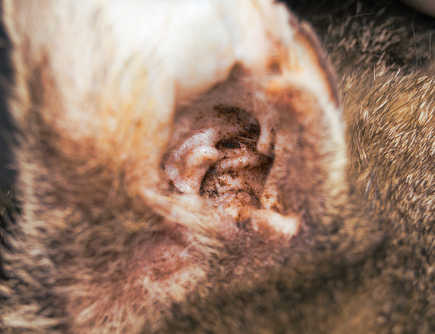
Malassezia in Cats is a common yeast that is a normal part of the flora (microenvironment) of the superficial layers of both human and animal skin. The organism usually lives on the skin, ear canals, oral cavity, and body orifices (vagina and anus) in low numbers. It usually causes no harm. In some cases, proliferation can occur and cause disease. Triggers for Malassezia overgrowth include increased humidity, skin trauma, and immune compromise.
Malassezia skin infections in cats may be local or generalized. Symptoms include:
- inflamed, reddened skin
- scaly or thickened skin
- overgrooming and itchiness
- areas of hair loss
- foul odor
- waxy buildup in ears
- skin acne or facial fold dermatitis
When a cat presents with Malassezia dermatitis, the treatment is similar to that for Candidiasis, but the course of treatment may take 4-6 weeks. If your cat gets a secondary bacterial infection, your vet will prescribe antibiotics.
Signs and symptoms of skin infection in cats
Signs of skin infections will vary depending on the agent and location of the infection. However, there are some common symptoms.
- licking or scratching the area
- excessive grooming
- pawing at ears/mouth
- rubbing on rough surfaces
- reddened, inflamed skin
- crusting or scabs
At-home treatments that can help (while you wait for your vet appointment)
While you’re waiting for your veterinary appointment, there are some things you can try at home to provide your kitty a little relief.
- Cool compresses – Cats usually won’t go for a cool bath to soothe irritated skin, but you may be able to apply cool washcloths to affected areas.
- Catnip bath or compress – Cats love catnip. Fortunately, it’s more than a treat. The plant can also help soothe itchy skin. Fill a tub with water and add some catnip leaves. Then encourage your kitty to get in the water. If she’s unwilling to take the plunge, try soaking a cloth in cool catnip water to use as a compress.
- Oatmeal remedy – Oatmeal has anti-inflammatory properties for the skin and can help to restore the skin’s protective barrier. Finely ground oatmeal can be used in a bath or a spray solution that you apply to your cat’s skin.
- Keep affected areas dry and clean – If your cat is amenable, gently clean the lesious and pat dry to remove any dirt or contamination.
- Use and E-collar – If your cat is constantly licking or grooming the area, you may need to use an E-collar to prevent the behavior.
Causes of skin infections
Anything that irritates the skin can potentially lead to pyoderma. Common causes include:
- Allergy – Particularly food, inhalant, or contact allergy which causes itching and irritation to the skin.
- Fleas – Some cats are particularly sensitive to the saliva of the flea, which results in a breakout of itchy papules on the skin.
- Ear mites – Spider-like mites which live in the ears of cats causing intense itching and discomfort.
- Ringworm – A fungal infection of the skin and claws, most cases of ringworm aren’t particularly itchy, but it can and does occur in some cats.
- Seborrhea – A condition caused by the overproduction of sebum, an oily substance produced by the sebaceous glands in the skin to protect and lubricate the skin.
- Hypothyroidism – A disease caused by an underactive thyroid gland.
- Cushing’s syndrome – A disorder caused by excessive production of cortisol by the adrenal gland. One symptom is a thinning of the skin, which can make it much vulnerable to damage.
- Diabetes – Type 2 diabetes is a condition in which the body’s cells don’t respond to insulin, a hormone that helps to move glucose into the cells. A side effect of diabetes is poor circulation and dry skin, both of which can cause itching, making it more vulnerable to infection.
- Demodicosis – Another type of mite which lives in the skin follicles or the surface layers of your cat’s skin. Immunocompromised or malnourished cats are most at risk. Itching leads to damage to the skin, making it prone to infection.
- Feline acne – Characterised by the presence of blackheads (comedones), particularly around the chin. These can become inflamed, leading to folliculitis, which is a form of skin infection of the hair follicles.
- Skin folds – Seen less often in cats than dogs, breeds with skin folds can develop pyoderma due to the skin trapping in moisture, in areas of folds, which provides the perfect environment for bacteria to proliferate. Prone areas include the nasal fold, vulval fold, and tail fold.
Diagnosis
Your veterinarian will perform a complete physical examination of your cat and obtain a medical history from you, including accompanying symptoms you have noticed. He may be able to make a tentative diagnosis based on presenting symptoms alone.
Depending on the findings of the initial exam, a diagnostic workup may include:
- Cytology – Examination of cells from a pustule under a microscope. This can help to identify the infectious organism, which may be bacterial or fungal.
- Culture and sensitivity – If a bacterial infection is identified, culture and sensitivity will be recommended. The bacteria are grown in a medium and then exposed to several types of antibiotics to determine which is the most effective in killing the bacteria.
- Skin scrapings may be taken to check for the presence of mites.
- Fungal culture may be used to look for ringworm.
- Food elimination trial – If a food allergy is suspected, your cat will be placed on a special diet to see if the allergy clears up, if it does, he will then be put back on his normal diet to see if symptoms return.
- Skin prick tests – A number of pricks are made in the skin containing allergens to common substances, the skin is then evaluated for a reaction to one or more of the allergens to identify possible allergies.
- Endocrine tests are used to evaluate for hypothyroidism or Cushing’s syndrome.
- Baseline tests including Biochemical profile, complete blood count, and urinalysis will be run to evaluate the overall health of the cat.
Treatment
The goal of treatment is to treat the underlying cause as well as the skin infection itself.
Treatment for skin infection:
- Oral antibiotics will usually run for 3-4 weeks.
- Topical antibiotics or antibiotic shampoos may also be necessary to help soften the crusts and treat the infection.
Treating underlying causes:
- Allergies – Avoidance of the allergen, if possible. Cats with food allergies will need to go on a hypoallergenic diet.
- Fleas – Diligent flea control, treat all cats as well as the environment as most of the flea life cycle in the environment, and not on the cat.
- Ear mites – Anti-parasitic medications such as Revolution.
- Ringworm – Anti-fungal medications, dips or shampoos.
- Malassezia – Medicated antiseborrheic shampoos every three days until the condition is under control.
- Hypothyroidism – Synthetic hormones to replace those not being made by the thyroid gland.
- Cushing’s syndrome – Surgical removal of the adrenal gland if a tumour is involved, or gradual withdrawal of corticosteroids if they are to blame.
- Diabetes – Dietary changes and or insulin injections.
- Feline acne – Keep the area clean with topical medications or witch hazel (for mild acne) and switch to glass or metal bowls.
